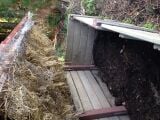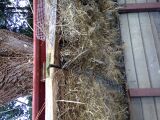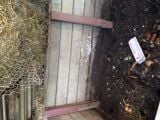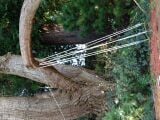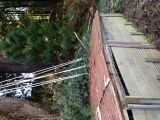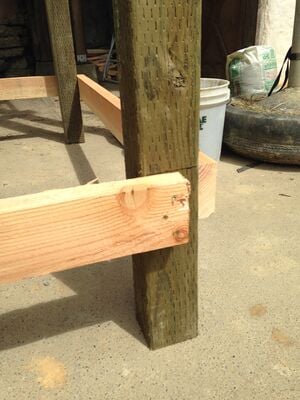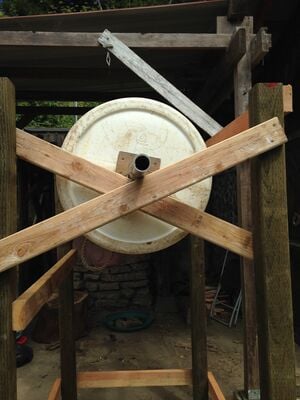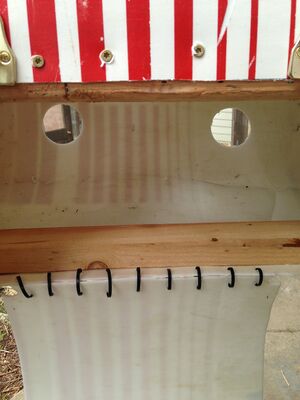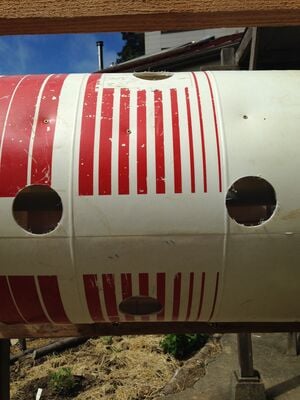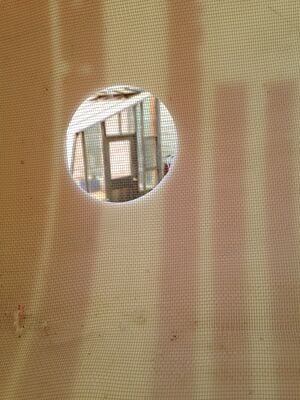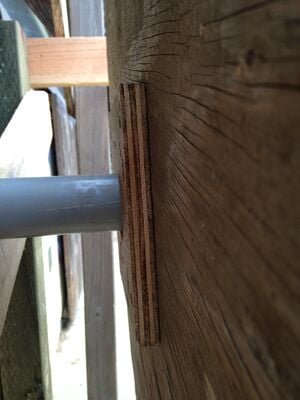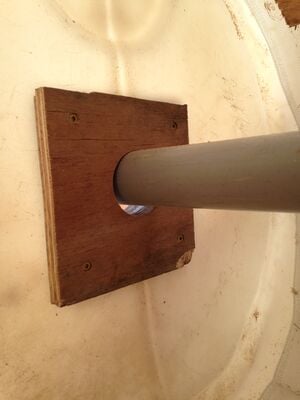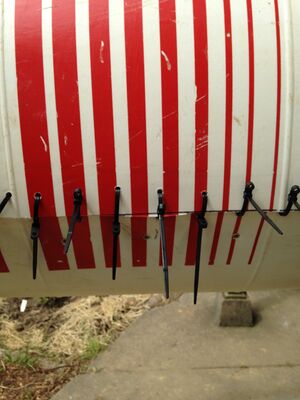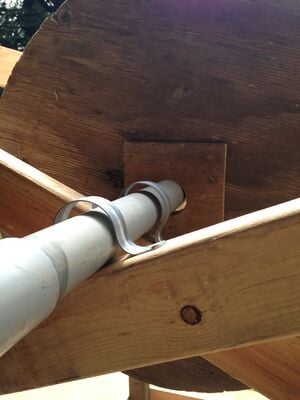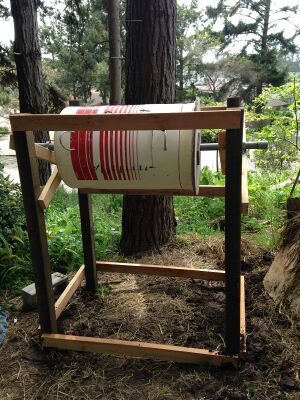
This tumbling composter is an easy to use, easy to build composting system that can turn your leftover scraps into nutrient rich soil for a multitude of different uses. Using readily available building materials one can construct their own tumbling composter to utilize at their homes, which this product will fit perfectly, especially at homes with limited space and like the cleaner appearance of a tumbler as opposed to a heap of steaming compost!. With increased aeration comes a speedier composting process, meaning more nutrient rich soil for your own personal use.
Background[edit | edit source]
For the Spring 2017 semester, we are rebuilding the Cal Poly Humboldt compost system at CCAT (the Campus Center for Appropriate Technology). CCAT is a model home dedicated to demonstrating renewable and carbon neutral practices you can do in your home. CCAT needs a new compost system because their current one doesn't have enough insulation and is difficult to use. As you can see below, the frame of the system is beginning to break down making it even harder to access the mature compost. A working compost system is essential to the identity of CCAT and needs to be functional as well as educational. The current compost system is a three part compost but the system we will be implementing is a tumbler compost system which will be more compatible with what CCAT needs. More details of different compost systems can be found below. This gallery shows photos of the current compost system in place.
-
Crank to lift lid of compost bin
-
Inside of compost bin
-
Lid insulation
-
Inside of compost bin
-
Lid pulley system
-
Full compost bin
Problem statement[edit | edit source]
The objective of this project is to redesign and rebuild a tumbler compost system for CCAT at HSU that is easy to access, use, and creates nutrient rich soil.
Composting Basics[edit | edit source]
"The word compost comes from two Latin roots, one meaning "together," the other meaning "to bring"".[1] This essentially boils down to the practice of combining a bunch of organic material together to create useful and organic fertilizer. Many cultures have re-purposed organic materials for farming, building material and fuel that it is hard to give credit to just one for the origin of composting.[2]
The basics of composting include organic material, a certain level of aeration, and insulation. The idea is that the insulated area creates its own heat which speeds up the decomposing process while the aeration helps to reduce the odor that decomposing material produces. The organic materials that can be composted are fruit/vegetable scraps from the kitchen, yard clippings, and paper materials. The things that should not be composted are meat, eggs (though the shells are compostable), dairy products and any material that has been processed such as metals or plastics.[3]
There is a balance of nitrogen and carbon to be aware of also. Carbon ("browns") is usually found in dried things like straw, dried leaves and wood chips. Nitrogen ("greens") is in most kitchen scraps and yard clippings. The ratio of carbon to nitrogen or browns to greens needs to be close to 25-30:1.[4] If there is too much carbon, the decomposition will slow down and if there is too much nitrogen the pile may begin to smell. The balance helps keep the microorganisms working with enough protein and energy to turn the organic matter into nutrient rich compost.
Methods of Composting[edit | edit source]
There are many different styles of composting. Determining which one is right for an individual is determined by a few different thing. How much waste is produced, how much maintenance is needed for the system and how quickly the compost matures are just a few elements to consider.
Barrel Compost
The barrel compost system is a relatively new system. It is a system that is easy to operate but there is some thinking to do about placement. This system doesn't have a large storage space but it creates mature compost in as little as one month.[5] The maintenance of this system is very easy. The barrel should be turned once a week for proper aeration and once the compost is matured it must be removed and the cycle starts again. The mature compost can be used right away or it can be stored elsewhere for later use. One down side to this system is that once the barrel is full, the addition of new materials must stop. This halts the constant production of compost but rather it is made in 'batches' which may not be compatible for high waste producing households.
3 Part Compost
A three part compost system is very useful. It takes up more room than a barrel compost but material can be continuously added and turned for the constant production of usable compost. The idea is to have a three blocks where one side is the incoming block, the middle block is the "in progress" compost and the last is the ready to use, finished compost. The maintenance is a somewhat involved, since the incoming compost must be moved to the middle compartment and then once again to the finished side. If mixed and proportioned properly, there shouldn't be much more maintenance than that but it is possible for it to need turning if it begins to produce odor.[6]
Vermiculture
Also called vermicompost, this uses worms to process the organic material. It has the same basic methodology as regular composting but the worms speed up the process and requite a little more attention. They are a little more sensitive to temperature which means they should be located close to a home or in the home itself. There also needs to be some specific things added to the compost in order to make it easier for the worms to breathe. Things that aerate the compost not only makes it easier for the worms to breathe and move around but it also cuts down on odor that is produced naturally by compost. There are many structures to choose from when housing the worms. The most common structure is the stackable unit. There are many square containers that have holes in the bottom of the unit. The basic idea of this unit is the new organic material is added to the top level. When there are no more levels to be added, the very bottom layer is taken out and the worms are removed from the mature compost. The worms are added back into the unit and the compost is used. The now empty level is placed on top and the process starts over.[7] The holes in the unit allow for the worms to move up toward the fresher organic material. Other structures have one level that they harvest more frequently and all at once. The maintenance of vermicultures require a little more work than the non-wormy compost. The worms need to be monitored and kept alive in extreme temperatures and when time comes to harvest the compost, they need to be sorted out of the compost in order to continue on with the cycle.
Construction[edit | edit source]
Size and cut wood according to specific measurements.
Measure out lengths on the wood. Once you've measured out every piece you will need, measure them again and then one more time. After the third time measuring, then go ahead and start cutting. Be very certain about your measurements before bringing out the saw.
Attach crossbeams to the short ends of the structure. Screw in the 2x4's in an X shape to provide support for the structure. The more of an angle the more sturdy the structure will be. This will also provide a place for the PVC pipe to rest on later in the process. Once you have the ends figured out, connect the ends in the back with two beams with perpendicular 2x4's. This step is fairly important. The points where the angled 2x4's should be level and line up exactly. If they don't, the barrel will wobble.
Drill aeration holes into tumbling container.
We decided to use 3" holes to create aeration. This will provide air flow and ensure that it doesn't start smelling. Something to consider is the size of the holes. The bigger the holes, the fewer you should have to keep the strength in the barrel and if the holes are smaller, you'll need more of them. Placing them too close to the door may also compromise the integrity of the barrel.
Line the inside with screen to keep materials inside.
Line the inside of the tumbler with mesh or hardware cloth to allow air flow through the holes while keeping the compost on the inside of the barrel. We stapled them in there but non-toxic glue is also a good way to keep it in place.
Attach support beams inside the barrel.
Place a few 2x4's the length of the barrel. This will not only keep the wiring in place but will also provide support to the plastic and prevent warping on the edge of the door. Reinforcing the door with a piece of wood will help keep it strong as well.
Attach squares on inside and outside of the ends.
Attach 4 square pieces of wood on the inside and the outside of where the rotational holes will be drilled. This will provide additional support and surface area against the friction of the drum spinning on the PVC pipe.
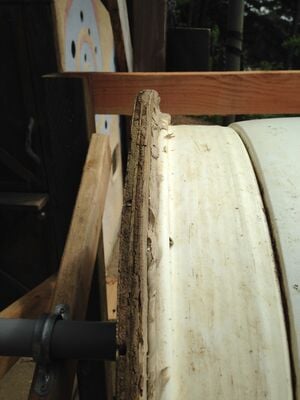
Attach a lid to the barrel to fully enclose the container. This step is only needed if you don't have a fitting lid for your container.
The 55 gallon drum we used didn't have a lid so we had to attach a circular wood cap and used caulk to properly seal the container.
Align and drill holes for rotation point.
Finding the center of the barrel is extremely important. If they aren't perfectly aligned the barrel will wobble. What ever the diameter of your pipe is, be sure to use a drill that is slightly bigger than the pipe. This will reduce friction and make placing the pipe much easier.
Drill a line of small holes on the door and the corresponding side to place zip ties.
Drill small holes that will fit the zip ties evenly along the hinge side of the door. Line up the holes on the corresponding side of the door so they will align to allow zip ties to hold the door in place.
Place PVC pipe through the barrel and secure with pipe straps.
Place the PVC pipe through the aligned holes on the sides of the barrel and put the completed barrel in place on the previously made stand. Once it is sitting snug in the axis of the boards, secure the pipe in position with pipe straps. This will prevent the tumbler from moving and ensure the tumbler can rotate on the axis without the PVC pipe moving.
Building Materials
Building materials for a compost system can range from anything from wooden pallets to recycled plastic bins you might find lying around. Depending on the size, location, and type of composting system you wish to build the materials may vary. Wire mesh and pallet planks can be used to build simple outdoor square or rectangular compost systems along with cinder blocks, bricks, or even cardboard for a simpler but less sturdy option.[8] If your building a tumbler composter, which is essentially a drum or any cylindrical contain that can be rotated to help move and aerate the compost inside materials such as trash cans, recycled food drums, or old wine barrels can be used.[9] Essentially all that needs to be accomplished is a contained, protected environment that successfully allows for the natural process of breaking down organic materials to occur. We went with a tumbling composter, using a plastic 55 gallon drum, suspended and rotating on a plastic pipe held up by a specifically designed wood support system.
Client Criteria
When speaking to CCAT about their needs we decided on building a whole new composting tumbler instead of trying to renovate the old existing one. there were a few elements that stood out as more urgent needs. One of those needs was making sure the tumbling bin would be high enough so that there could be wheelbarrow access underneath, making for easy access to the mature compost. The current compost bin has a very heavy lid, and decaying infrastructure making access to the compost very difficult. Another important criteria was that the bin rotate smoothly and efficiently without much wear and tear on the axle. This would make it much easier to use and would significantly increase the lifespan of the bin, making maintenance much less of an issue. There was a mention of pests but this isn't a very urgent problem, just something to keep in mind while designing.[10]
Criteria
| Criteria | Constraints | Weight (1-10) |
|---|---|---|
| Accessibility | Mature compost must be easily accessible and unit must be easy to open | 9 |
| Aesthetics | Compost bin should look professional and pleasing to look at | 8 |
| Cost | Must not exceed budget (max $200) | 6 |
| Dimensions | Should have dimensions close to 3ft off the ground X 3ft wide, enough for a wheel barrel to fit under | 7 |
| Materials Used | Materials should coincide with appropriate technology techniques | 9 |
Proposed Timeline
| Activity | Due Date |
|---|---|
| Visit local examples of composting systems | February 17-19, 2017 |
| Finalize budget | February 25, 2017 |
| Prototype/design new system | March 1, 2017 |
| Acquire building materials | March 3-5, 2017 |
| Build new compost | April 6-11, 2017 |
| Redesign/ make changes if needed | April 12-16, 2017 |
| Continued construction and made changes | April 19-May 5, 2017 |
| Present final project | May 9, 2017 |
Proposed Budget
Our funding will be coming from CCAT and will simply be used on buying the building materials to upgrade the compost system.
| Quantity | Material | Source | Cost ($) | Total ($) |
|---|---|---|---|---|
| 4 | 4x4x8 Pressure Treated Wood | The Mill Yard | $10.99 | $43.96 |
| 2 | 2x4x18 Douglas Fir Wood | The Mill Yard | $7.19 | $14.38 |
| 2 | Metal locks | Ace Hardware | $9.99 | $19.98 |
| 1 | 5' of sturdy rope (for rotating) | Ace Hardware | $6.00 | $6.00 |
| 1 | 15 ct bag of zip ties | Ace Hardware | $4.50 | $4.50 |
| Total Cost | $88.82 | |||
Costs
| Quantity | Material | Source | Cost ($) | Total ($) |
|---|---|---|---|---|
| 4 | 4x4x8 Pressure Treated Wood | The Mill Yard | $10.99 | $43.96 |
| 2 | 2x4x18 Douglas Fir Wood | The Mill Yard | $7.19 | $14.38 |
| 2 | Metal locks | Ace Hardware | $9.99 | $19.98 |
| 1 | 5' of sturdy rope (for rotating) | Ace Hardware | $6.00 | $6.00 |
| 1 | 15 ct bag of zip ties | Ace Hardware | $4.50 | $4.50 |
| Total Cost | $88.82 | |||
Operation[edit | edit source]
Operating this composting tumbler is very simple. Simply put your compostable goods inside the bin, rotate once a week for aeration which increases composting rates, and empty your new nutrient rich soil once a month. One thing to keep in mind is once the tumbler is full, don't add any more materials to the bin until the composting process is finished.
Maintenance
Maintaining this tumbler compost is very easy. The compost needs to be monitored to see if the components are at the correct ratio. Checking and replacing the zip ties, cleaning and replacing the inner screen, and maintaining a smooth rotational platform for the bin to rotate on are the few requirements to keep a well working compost system.
Schedule
- Daily
- Rotate barrel to ensure proper aeration.
- Monitor ratios of the compost and add components as needed.
- Weekly
- Monitor the fullness level of the compost and stop adding material when it is full.
- Make sure rotating axles are clear of any debris.
- Monthly
- Empty bin of compost and clean off screens to make sure there is air flow to the system.
- Monitor the structure of the bin and replace elements when needed.
- Yearly
- Check to see if zip ties are holding and replace when needed.
- Make sure inner screen layer is clean and intact and replace if needed.
Conclusion[edit | edit source]
Testing results
Unfortunately, we did not have enough time to properly test the compost making capabilities of our product. We did test the mechanical abilities which were nearly perfect. The axis is properly made and the structure is very strong and sturdy.
Discussion
Without the results of our testing, we don't have anything to discuss.
Lessons learned
We should have started building our compost at an earlier date to compensate for unforeseen complications. Also, making sure we had proper communication with our clients was something that would have made this project much smoother and would have ensured the completion of out project much faster.
Next steps
The next steps for this composting system would be to fully seal the door to the bin so that the chances of material falling out would be reduced. Finding it a permanent home is something that will need to happen as well because it is currently located in a spot that as of right now its located in a spot not meant for a compost of this style. It is on a hill and isn't buried in deep enough. Being buried properly will not only secure it in place but it will also allow for easy wheelbarrow access. A nice paint job could be nice for the system but it may not be necessary or needed.
Troubleshooting
| Problem | Solution |
|---|---|
| Door doesn't stay closed. | Make sure the locks are holding secure and add a lock of some kind if needed. |
| The barrel isn't rotating smoothly. | Check to see that there's no obstructions in the rotating axles. Also try making the hole larger. |
| The compost is not getting enough aeration. | Check the screens and make sure they aren't clogged. Rotating the barrel more frequently would help with this as well. |
Team[edit | edit source]
Introduce team and semester in the following format:
References[edit | edit source]
- ↑ Campbell, Stu. "Let it rot!". Storey Publishing. 1993. Pg. 3
- ↑ Smith, Martha, and Duane Friend. "History of Composting." History of Composting - Composting for the Homeowner - University of Illinois Extension. Accessed January 26, 2017. http://web.archive.org/web/20190512141900/https://web.extension.illinois.edu/homecompost/history.cfm.
- ↑ Elmore, Dave. "Composting Basics & Getting Started." Green Action Centre. September 9, 2010. Accessed January 26, 2017. http://greenactioncentre.ca/reduce-your-waste/composting-basics-and-getting-started/.
- ↑ Adekalu, K.O., Ogunjimi, L.A.O., Ogunwande, G.A., Osunade, J.A. (2008, November). Nitrogen loss in chicken litter compost as affected by carbon to nitrogen ratio and turning frequency. Bioresource Technology. Volume 99 (Issue 16), pp. Pages 7495–7503.
- ↑ "How to Compost in a Rotating Barrel." Home Guides | SF Gate. Accessed January 26, 2017. http://homeguides.sfgate.com/compost-rotating-barrel-78337.html.
- ↑ Martin, Deborah L., Grace Gershuny and Jerry Minnich. The Rodale Book of Composting. Emmaus, PA: Rodale Press, 1992.
- ↑ Appelhof, Mary. Worms Eat My Garbage. Kalamazoo, MI, USA: Flower Press, 1997.
- ↑ Admin. 18 Cool DIY Compost Bin Designs. Compost Guide: tips for home composting. 2013 Online article. http://compostguide.com/18-cool-diy-compost-bin-designs/
- ↑ G6957. How to build a compost bin. Uinversity of Missouri Extension. Online article. 1993 http://extension.missouri.edu/p/G6957
- ↑ Anderson, Austin. "CCAT Compost." Interview by author. January 27, 2017.

